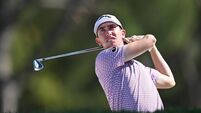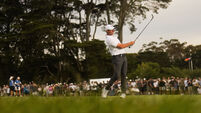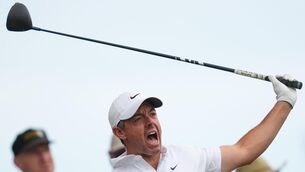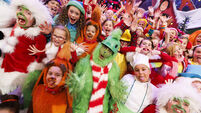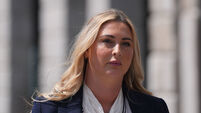Phil Mickelson deserves better than a silent US Open exit

Mickelson deserved a hero’s sendoff even if he never got hoist that US Open trophy over his head.
Was that it? Is that the last time we’ll see Phil Mickelson in a US Open? Is our last image of the left-hander in his national championship slumping off the ninth green in silence after three-putting from inside 2 feet for bogey on his last hole at Winged Foot?
If this was his 29th and final appearance in his national championship, Phil the Thrill deserved better than this. He deserved a crowd appreciating every errant drive the way fans at Hoylake got to lift the spirits of Seve Ballesteros. He deserved his prodigious New York fan club flanking all sides of the last hole to stand and cheer his final walk the way the crowds did for Arnold Palmer at Oakmont and Jack Nicklaus at Pebble Beach, St Andrews, Valhalla and Augusta.
Mickelson deserved a hero’s sendoff even if he never got hoist that US Open trophy over his head.
For more than a quarter-century, Mickelson has been arguably the richest protagonist in US Open history. Tragic hero. Comic relief. Sentimental favorite. Petulant villain.
We’ve marked his march from teenage amateur phenom in 1990 to senior player with annual birthday serenades in normal years. We’ve gotten to share prayers for the cancer recoveries of his wife, Amy, and mother, Mary, at Bethpage.
We’ve watched his oldest child, Amanda, grow up – out of sight but never out of mind every June. From the baby beeper on the eve of her birth at Pinehurst in 1999 to the cross-country commute for her middle school graduation awards in the eve of Merion in 2013 to skipping 2017 at Erin Hills entirely for her high school graduation.
Phil Mickelson has been the story of the US Open every year. His long-running saga of unrequited desire has delivered more consistent plot lines than a soap opera.
A record six times in a 15-year span (40%) from 1999 to 2013 he walked away with the silver medal as runner-up. His resume of heartbreak is remarkable for anyone, much less a guy whose driving accuracy has never been exactly USGA certified.
His peers even marveled at his Sisyphean determination.
“Of all the events, you would think that this would be the (major) that he would have the least chance to win because of the way he’s driven it for most of his career,”
Tiger Woods once said of his longtime rival. “But that short-game of his is off the charts. ... He’s made some of the more difficult pars that you have to make to win this tournament, it’s just that he hasn’t (won it).”

Too often Mickelson had to grin and bear his fate with unimaginable grace. He smiled between Payne Stewart’s hands as he headed to fatherhood at Pinehurst. He lamented his luck at Shinnecock. He called himself an “idiot” at Winged Foot. He admitted “heartbreak” at Merion.
He even laughed off his second runner-up turn at Bethpage Black when a three-way tie for second in 2009 left the USGA one short of the necessary silver medals for the awards presentation. “I’m good,” Phil said.
With the possible argument from the heirs of Sam Snead, there is no more compelling tragic figure in US Open history than Mickelson. His six defeats have been as epic in scale as his five career major triumphs.
Other than in 2002 at Bethpage, when he (and everyone else) never really threatened Woods on Sunday before finishing three strokes back, there was always a late moment of drama when everyone was all but certain that we would be writing about Mickelson’s triumph. Those near misses are on every golf writer’s save string.
In 1999 at Pinehurst, despite carrying a beeper that might have summoned him home to be at Amy’s side for the birth of their first child at any moment, Mickelson led by one with three holes to play before Payne Stewart sank him with three consecutive one-putts totally 55 feet.
In 2004 at Shinnecock, Mickelson birdied three of four holes to take a one-shot lead with two to play on Retief Goosen before make a double bogey from a rock-impeded lie in the bunker on the par-3 17th hole.
In 2006 at Winged Foot, despite fighting his control that once literally found the bottom of a rubbish bin, he held a one-shot lead on the 18th tee before hitting a tent, a tree and a bunker en route to a shocking double bogey that left the trophy to Geoff Ogilvy.
“I still am in shock that I did that,” he said afterward. “I just can’t believe that I did that. I am such an idiot.”
In 2009 at Bethpage, with his wife’s recent breast cancer surgery on his mind, he held the lead again late in the final round after making eagle on No 13 only to make bogeys at 15 and 17 to finish two behind Lucas Glover.
Then in 2013 at Merion, he vaulted into a share of the lead again Sunday with a chip-in eagle on No. 10 before derailing himself with a bogey on the short par-3 13th en route to another numbing runner-up to Justin Rose. Mickelson called that one “heartbreaking” and “probably the toughest for me.”
He’s always had trouble quantifying his pain. He says Merion. His former caddie, Jim 'Bones' Mackay, says Shinnecock was the most difficult to swallow. Most observers can’t shake the gruesome finish at Winged Foot when he was one hole from winning a third consecutive major.
In every case except the time Tiger beat him, he’s usually been his own worst enemy – the what-will-Phil-do poster child of major agony. In his six runner-up efforts, Sunday has been his downfall. Mickelson averaged 68.5 (9-under par) in the opening rounds, 70.66 (+4) on Fridays, 70.16 (+1) on Saturdays and a crippling 71.50 (9-over) on Sundays. Even worse, he played the last three holes on Sunday in a collective 9-over par after playing the first 15 in a collective even.
Mickelson has had six attempts to complete his career slam since his surprising victory in the 2013 Open Championship at Muirfield just a month after his Merion heartbreak. The first try was at Pinehurst, which seemed the perfect spot for a fairytale ending.
“It would really mean a lot to me ... to do it right here where Payne and I had this moment where we talked about fatherhood, but he also talked about winning future US Opens,” Mickelson said then when he was still just 44.

Time, however, is cruel, and undefeated. Despite all out hopes that familiar and comfortable places like Pinehurst, Shinnecock, Pebble Beach and Winged Foot might rekindle one last bit of genius, he could never again feature. He’s long passed the age of Hale Irwin, who at age 45 in 1990 became the oldest US Open winner the same week that Mickelson turned 20 and claimed low amateur in his major championship debut.
At 50 now, this week always looked like his last reasonable hope. Despite winning handily in his PGA Tour Champions debut a few weeks ago, Mickelson arrived at Winged Foot lacking any confidence. He was wild off the tee for two days, growing increasingly and openly frustrated as he struggled to find his game.
“I don’t know what to say. It’s a disappointing day,” was his terse assessment of Thursday’s 79.
On Friday, after blowing a birdie chance from 1 foot, 10 inches on the last, he left the course without comment. After three decades of pushing that rock up the USGA hill, he’s run out of things to say.
He’s still No 53 in the world and still Phil Mickelson, so qualifying again in 2021 for a 30th U.S. Open in his hometown at Torrey Pines is not out of the question. He could make it back as a U.S. Senior Open champ, too. While a 36-hole sectional qualifier is a big ask, he certainly warrants at least one special exemption, though he insists he’d decline it without making it in on merit.
Mickelson has never been one to quit, even as it seems obvious to everyone that his window of opportunity has closed. But as he said last year when he failed to win a second time when it most mattered in 2019 at Pebble Beach, “I don’t know what else to say. It’s not like I’m going to stop trying.”




